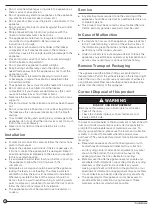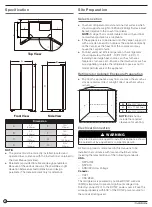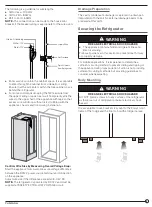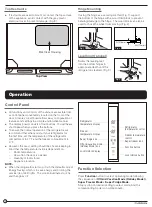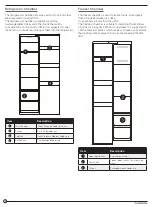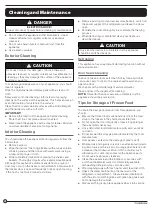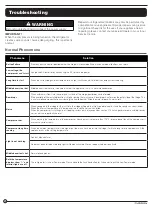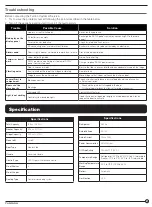
11
Cleaning and Maintenance
DANGER
ELECTRIC SHOCK!
Always disconnect power before cleaning or maintenance
●
Do not clean the appliance with metal objects, steam
cleaner, ethereal oils, organic solvents or abrasive
cleansers.
●
Do not use sharp objects to remove frost from the
appliance.
●
Use a plastic scraper.
Exterior Cleaning
CAUTION
Don’t use Thinner, Car detergent, Clorox, ethereal oil,
abrasive cleansers or organic solvent such as Benzene for
cleaning as they may damage the surface of the appliance
and may cause fire.
To maintain good appearance of your appliance, you should
clean it regularly.
Wipe the digital panel and display panel with a clean, soft
cloth.
Spray water onto the cleaning cloth instead of spraying
directly on the surface of the appliance. This helps ensure an
even distribution of moisture to the surface.
Clean the doors and cabinet surfaces with a mild detergent
and then wipe dry with a soft cloth.
IMPORTANT!
●
Remove the food from the appliance before cleaning.
Store them in a cool place and well covered.
●
Never clean the appliance with a steam cleaner. Moisture
could accumulate in electrical components.
Interior Cleaning
You should clean the appliance interior regularly. Follow the
below steps:
●
Remove all food.
●
Wipe the inside of the fridge freezer with a weak solution
of baking soda, and then rinse with warm water using a
wrung-out sponge or cloth.
●
Wipe completely dry before replacing the shelves and
baskets. Thoroughly dry all surface and removable parts.
Although this appliance automatically defrosts, a layer of
frost may occur on the freezer compartment’s interior walls if
the freezer door is opened frequently or kept open too long.
If the frost is too thick proceed as follows:
●
Remove existing food and accessories baskets, switch off
the power supply of the refrigerator and leave the doors
open.
●
Ventilate the room thoroughly to accelerate the thawing
process.
●
When defrosting is completed, clean your freezer as
described above.
CAUTION
Only after the interior is completely dry the appliance
should be switched back on.
Defrosting
This appliance has an automatic defrosting function without
manual operation.
Door Seals Cleaning
Take care to keep door seals clean. Sticky food and drinks
can cause seals to stick to the cabinet and tear when you
open the door.
Wash seals with a mild detergent and warm water.
Rinse and dry it thoroughly after cleaning.
NOTE:
Only after the door seals are completely dry the
appliance should be powered on.
Tips for Storage of Frozen Food
To obtain the best performance from this appliance, you
should:
●
Be sure that frozen foods are transferred from the food
store to the freezer in the shortest possible time.
●
Do not open the door frequently or leave it open longer
than absolutely necessary.
●
Once defrosted, food deteriorate rapidly and cannot be
re-frozen.
●
Do not exceed the storage period indicated by the food
manufacturer.
●
Hot vapours can lead to the damage of plastic parts.
●
Ethereal oils and organic solvents can attack plastic parts,
e.g. lemon juice or the juice from orange peel, butyric acid,
a cleanser that contain acetic acid. Do not allow such
substances to come into contact with appliance parts.
●
Do not use any abrasive cleansers.
●
Clean the appliance and the interior accessories with
a cloth and lukewarm water. Commercially available
dishwashing detergents may also be used.
●
After cleaning wipe with fresh water and clean dishcloth.
●
Check the water drain hole on the rear wall of the
refrigerator compartment. Clear a blocked drain hole
with the aid of something like a soft green peg, take care
not to damage the cabinet.
●
After everything is dry place appliance back into service.




